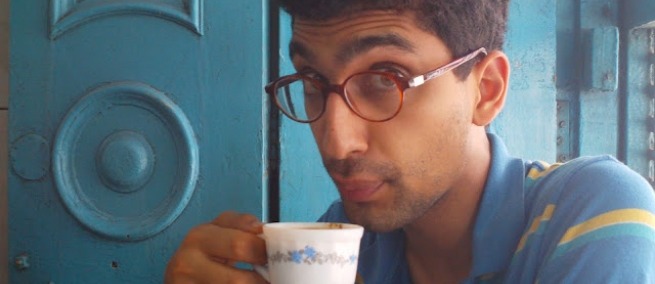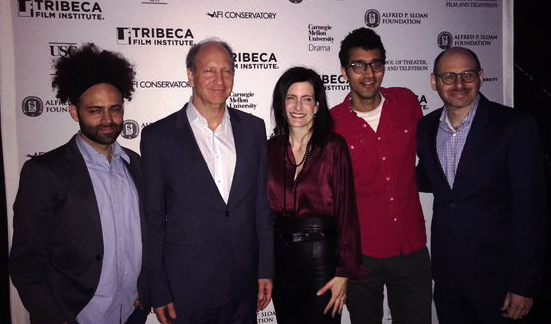
Radiolab is WNYC’s radio show that explores science, philosophy, and human experience. Latif Nasser is its Director of Research. Looking for true stories about science and crafting them into a narrative, Nasser’s job is a combination of his training as both a playwright and historian of science. In 2016 Nasser was on a Sloan Jury, which combined artists and scientists (including actress Emily Mortimer and the Science Channel’s Marc Etkind), at the Tribeca Film Institute to pick the winner of the Student Grand Jury Prize. Shawn Snyder was selected for his script TO DUST. According to Snyder, TO DUST is about “Shmuel, a Hasidic man in upstate New York who loses his wife, and struggles and fails to find comfort in traditional Jewish mourning rituals, while growing increasingly haunted by thoughts of her decomposing body. He is driven to understand the actual physical process of her decay in hopes that it might offer some solace.”
Science & Film went to WNYC’s headquarters where Radiolab hosts Jad Abumrad and Robert Krulwich were in the midst of taping an episode. We spoke with Latif Nasser about the jury selection process, his job at Radiolab, and crafting stories about science.
Science & Film: Did you feel prepared by your job at Radiolab to be on the Sloan jury?
Latif Nasser: I read each of the scripts a bunch of times and the thing I was thinking of was: these are all fictional, obviously, but if they weren’t, could they be Radiolab episodes? Would I want to make an episode about this? Would I want to listen to an episode about this? If I were writing it, would I have structured it differently?
TO DUST is a terrific story. If it was a nonfiction story I would want to report on it because it is just so good. Often when I am structuring stories to be Radiolab episodes, there are two parts of my brain that have to be committed to exactly opposite ideas: there is one part of my brain that thinks it really matters that this is true and that we’re being honest and honestly representing this thing as it exists, because this is nonfiction—that is very, very crucial; then there is another part of my brain that is like okay, if this were fiction, what’s the best possible way this could go? Who is the character I would want to hear from? What’s the plot twist that I would never see coming? Reading these scripts is so fun because you get to just jettison that worry, that anxiety about it being true, and whatever the writer wanted to happen could happen. Maybe for a lot of screenwriters that’s an obvious thing. But for me, it’s definitely not. I am giddy at the potential of it. I brought a nonfiction, documentary set of eyes to a fictional screenplay.
.jpg)
S&F: How do you approach creating a story in your job, and were you impressed by the way these students approached scientific ideas?
LN: They did do it really well in the way that I think we try to do, which is that it’s not hammering you over the head as a science lesson. Narratives seduce you and you realize you’re caring about something that you didn’t know you cared about. TO DUST is such a good example because it so perfectly marries these two drives. One is the drive to learn more about body decomposition which seems maybe interesting but kind of morbid—not something you necessarily spend your free time reading about. But, then when you couple it with this man’s genuine grief and mourning it means so much more and you care so much harder—every detail matters. It matters in a way it would never matter if you were just reading a textbook; I think that is the way you have got to do it. Otherwise it’s no fun, it’s just technical.
S&F: How did the artists and scientists on the jury judge the science part of the screenplays?
LN: You could see that different writers had done their homework to different degrees. I think we were noting that, and the few of us who did have that kind of science experience and background were saying, oh yeah, I know about this, and this guy really nailed that, or not. Another thing you have to take into account is that the different scripts were tackling different topics that had different degrees of difficulty. There were some topics that maybe are slightly less accessible and comprehensible so you kind of have to cut a little slack. Whereas for certain other topics you would say, oh okay, this person has done his or her homework but this is kind of a topic that’s everywhere and it’s much easier and relatable. That is not a knock against it, but it just means that the threshold is that much higher, you have to do that much better to make it sing. As a writer, to both give you that drive to care and to give you that stuff to learn, is so fulfilling.

I think it is so often the case that we don’t know we care about something until someone writes something which clicks it in so it’s like, oh that’s why I care about this, oh this is not actually about fungus taking over the flesh–this is actually about something so human and deep and personal and emotional–it is not about this cellular process.
S&F: So is that how you approach stories at Radiolab?
LN: That is how we approach it here. A lot of these topics, they are really interesting to know in and of themselves and there are people who learn about them, and more power to them. But for us, it has to be a way to either understand some kind of character’s journey or to open a question that is a pressing one we all are facing, or to marvel at something that means a lot more than just cells bumping into each other. It has to have some kind of metaphysical or philosophical resonance. For us, it is not just about teaching someone, it is about making them care about something, and there is a world of difference between those two things.
S&F: Part of the Sloan Film Program is incentivizing film students to tackle scientific subject. Is that something you think about here?
LN: They’re putatively students, but I think the caliber of the scripts was really good. They didn’t feel like students, which was really impressive. That idea of bringing stories from directions you wouldn’t expect, making connections between technical fields and liberal arts, that is what we try to make our bread and butter here. It is not just because we want to make some musty textbook interesting, it’s because we live in this crazy world, where there are so many things to really care about. If you look at it from the right angle, everything becomes interesting. In some ways, it is your fault if you are not seeing this thing as interesting.
I was such a big fan of TO DUST. A bunch of the jurors, we were like, when this movie gets made, we’re all going to the movie theatre together. I really hope he finds so much success. I’ve never lost a spouse, but I felt what it was like to be that person and it was so vivid. The script really took you to that place. It’s a stunning accomplishment.
S&F: When did you first realize what dramatizing science could do?
LN: I went through several phases actually. When I was an undergrad the thing that consumed me all the time was playwriting. I was writing in the Sloan vein of dealing with science and issues about science and the history of science without being too didactic. I wrote a play as my senior thesis about Einstein’s turbulent younger years. And then I went to grad school and studied the history of science, so it was still stories about science, I was just writing them in a different way. I love finding these histories in which you could see a lot of contemporary concerns. Then I moved into radio, which in some ways I see as a combination of the two—the free form creative writing dimension of being a playwright, plus looking for true stories like being a historian. In a way I feel like I get the best of both worlds here: I get to play with structure and form and all those kinds of things, but at the same time engage with real people and things that are really happening. There have been so many great plays and so much great scholarship and so many great books in the history of science, there’s so much potential. The best stuff, like TO DUST, which I could categorize up at the top there, can make you feel and think and learn things that you didn’t realize you cared about. You read it and you are in it and you are crying and that is the potential to me—to just get swept away. So many of the things that Sloan does has that potential and it is such a thrill.
Shawn Snyder was interviewed by Science & Film about his script TO DUST after it won its first Sloan grant in December 2015. He plans to shoot the film this fall. The Sloan Foundation program encourages the next generation of filmmakers to tackle science and technology themes and characters.
Latif Nasser’s most recently reported episode on Radiolab is “On the Edge,” about a legendary figure skater from the 1998 Olympics.
FILMMAKERS
PARTNERS
TOPICS